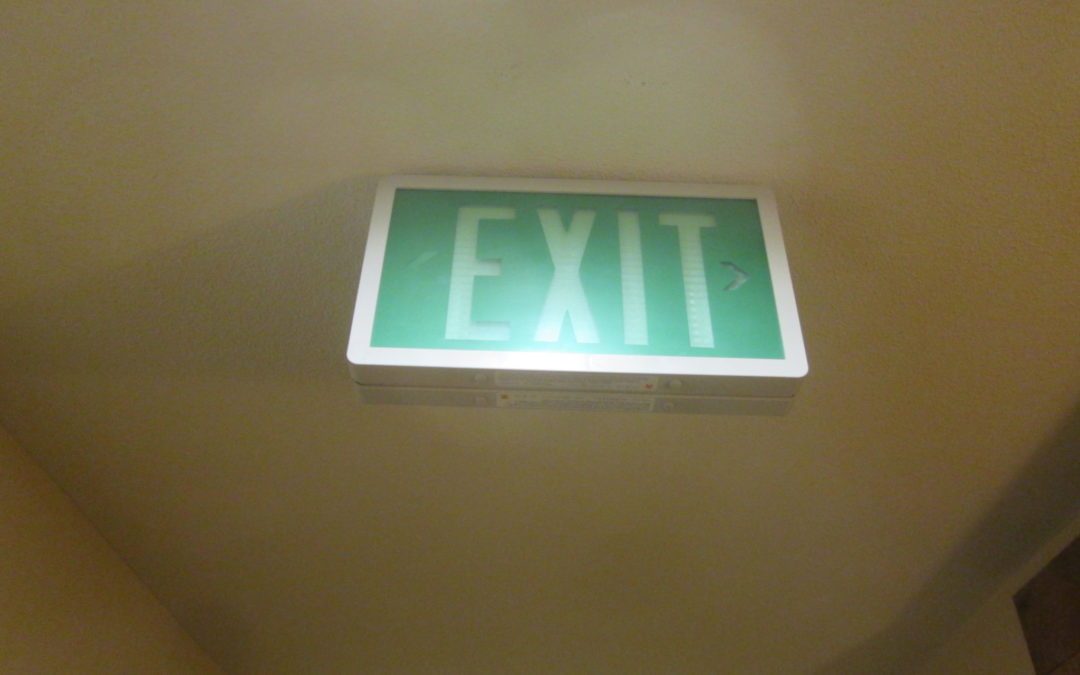Don’t Let the Lights Go Out! Self Luminous Exit Signs

Self-luminous or photo-luminescent exit signs are a newer type of exit lights that do not require electricity.
These types of lights have a set lifespan of 10, 15 or 20 years and are becoming more common in newer buildings, especially as low mounted “crawl” exit signs become required or in historic buildings, where running new electrical wiring is cost-prohibitive. Many properties are beginning to face the replacement of these exit signs for the first time and are surprised that the process can be longer and more expensive than with traditional exit signs due to special disposal requirements for some devices and long lead times for some replacement devices. Due to the set lifespan of this type of sign, all of the signs in a building typically expire at the same time, which can result in a large unbudgeted repair. Lights are usually sold as 10, 15, or 20-year models and the lifespan directly influences the pricing.
The most common element used to allow exit signs to glow without using electricity is Tritium. Tritium is the only known radioactive isotope of hydrogen and is present everywhere on earth. Tritium’s unique properties and very low radioactive profile make it useful for a wide range of applications such as analog watches, low-light binoculars, and emergency lighting and signage.
More Information On
Disposal Of Self Luminescent Exit Signs
(Disposal Of Tritium Exit Signs)
Illumination occurs in the signs when a special phosphor coating is applied to a glass tube and tritium is allowed to interact with the coating. The atoms are stimulated in a process that is similar to how microwave ovens heat food. This causes the coating to glow relatively bright in the visible light spectrum, creating a completely independent but perfectly reliable exit sign under emergency conditions. Remember, these lights do not rely on electricity which allows them to stay working during extended power interruptions or natural disasters.
Photo-luminescent signs do require slightly different testing procedures than conventional emergency exit signs. Every month the signs need to be visually inspected for physical damage. Annually the signs need to be monitored for 90 minutes in a dark environment after being in a fully lit environment for 1 hour immediately preceding the test. Any device that fails to meet the minimum luminosity requirement after the 90-minute test or is past its expiration date needs to be replaced. Tritium based lights are also registered to the property and require special handling and disposal.
Tritium exit signs are designed to reduce the risk of radioactive material escaping into the environment. Not only is the tritium packaged in glass tubes engineered to resist breakage and damage, but the overall sign package is designed to be impact- and tamper-resistant. And if it did, you would only receive about 1/3000th of the radioactive dosing from a regular chest X-ray. Although tritium is relatively safe, especially in terms of radioactive materials, the Nuclear Regulatory Commission and the National Nuclear Security Administration monitor tritium usage carefully and have strict protocols for working with and disposing of tritium-based materials. These protocols govern storage, use, and disposal of tritium exit signs
As tritium exit lights reach the end of their working lives, there are fee’s which go to the disposal facilities and they must be disposed of in accordance with federal, state and local regulations. When replacing lights which have reached their expiration date or have failed their annual test, we can exchange tritium lights with alternative photo-luminescent lighting solutions which use no power and still meet UL924 requirements. Proper replacement will ensure proper emergency lighting effectiveness and minimize liability for your property.
For more information about emergency and exit lighting, we invite you to contact us at statcares@statcomm.com
Check out our other Newsletter articles below…
Hello readers, Captain Contest strikes again!
Statcomm Employee Spotlight: Corey Haney
Did You Know? The New Requirements For Fire Sprinkler Technicians
What to Expect When Expecting Statcomm
